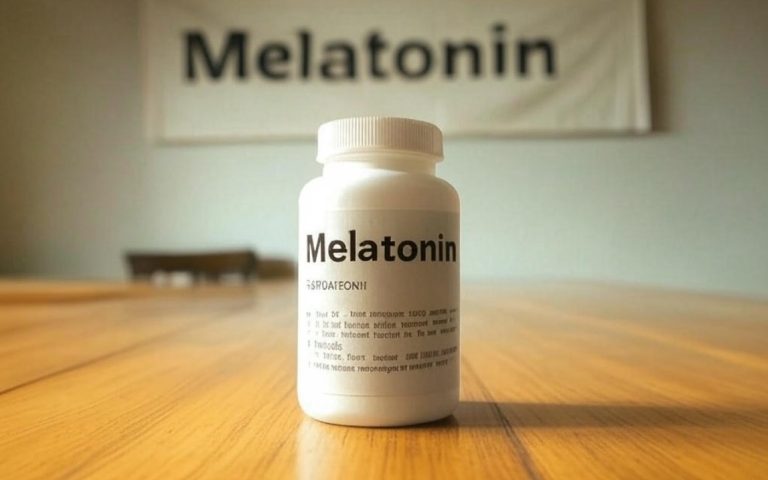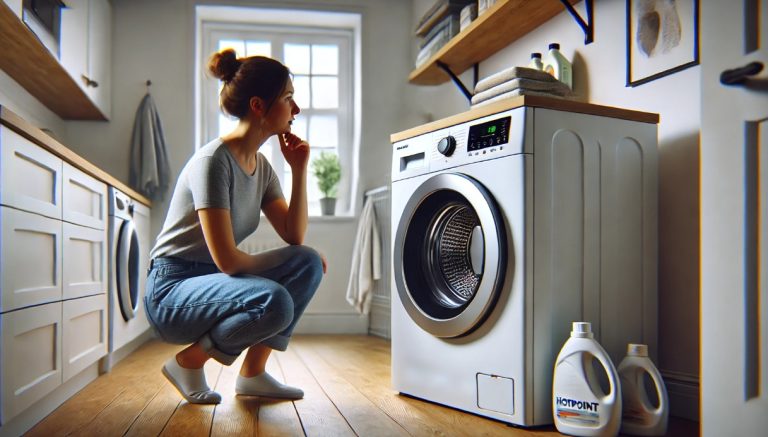Why is There Condensation on the Outside of My Windows?
Condensation on the outside of windows is a common phenomenon that often causes confusion and concern for homeowners.
While many associate condensation with damp problems or window faults, exterior condensation is often a sign that your windows are functioning efficiently.
Understanding why this happens, when it’s normal, and what it says about your glazing can help reassure and inform homeowners looking to protect their property and improve energy efficiency.
What Causes Condensation To Form On The Outside Of Windows?
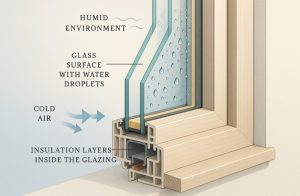
Condensation forming on the outside of windows is often misunderstood. While some may see it as a defect or concern, it is actually a natural physical process driven by specific environmental conditions. To fully understand why it happens, it’s important to break down the science and contributing factors.
1. Surface Temperature And The Dew Point
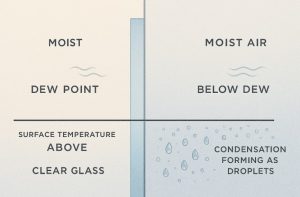
The primary cause of exterior condensation is the relationship between surface temperature and the dew point of the surrounding air.
The dew point is the temperature at which air becomes saturated and can no longer hold moisture in the form of vapour. When the outer surface of a window drops below this point, water vapour condenses into liquid droplets on the glass.
At night or in the early morning, the temperature of the outer glass pane can fall significantly, especially when skies are clear. If the air around the glass is humid and still, condensation will begin to form. This is often seen as mist or beads of water on the surface of the pane.
2. Radiational Cooling At Night
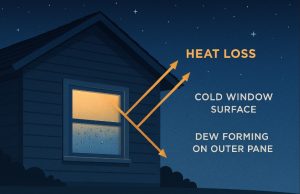
One of the most influential factors in the formation of external condensation is radiational cooling. This refers to the process by which a surface loses heat through radiation, particularly during clear nights.
When there is no cloud cover to reflect heat back toward the ground, the window’s surface loses thermal energy rapidly. Since the window is not receiving warmth from inside the house — due to the insulation of double or triple glazing — it becomes cooler than the surrounding air, leading to condensation.
Radiational cooling is strongest:
- On clear, calm nights
- When there is no wind to mix warmer air
- In open areas without overhanging structures
3. The Role Of High Humidity
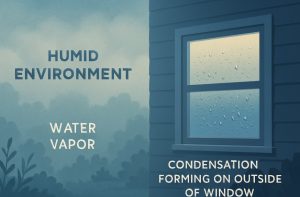
Even a cold window will not experience condensation unless the ambient air is sufficiently humid. High humidity levels in the external environment increase the likelihood that the air’s dew point will be reached. This is why condensation is more common near gardens, water features, or in coastal locations.
In the UK, overnight humidity often remains high, particularly in the spring and autumn. This moisture-rich air, when combined with a cold window surface, creates ideal conditions for dew to form.
4. Effect Of Glazing Efficiency On External Condensation
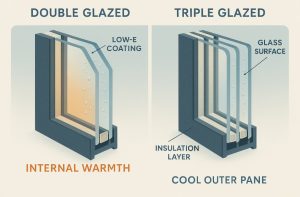
Modern energy-efficient windows are designed to prevent heat from escaping a building. While this is beneficial for indoor comfort and reducing energy bills, it also means that less warmth reaches the outer pane, especially in double and triple glazed units.
Most high-performance glazing includes:
- Low-E coatings: Reflect heat back into the room
- Gas fills: Such as argon, which reduce thermal conductivity
- Thermal spacers: Improve edge-of-glass insulation
As a result, the outer pane remains cooler than the air outside, particularly at night, making it more likely for condensation to form. Ironically, the presence of external condensation is often a sign of good insulation and efficient thermal performance.
5. Influence Of Window Orientation

The orientation of a window can also impact the likelihood of external condensation. Windows facing north or east are more prone to morning condensation because they receive less early sunlight, which would otherwise help raise the surface temperature and evaporate any moisture.
In contrast, south and west-facing windows are usually exposed to more direct sunlight, which reduces the duration and visibility of condensation.
6. Environmental And Surrounding Factors

External surroundings can contribute to condensation levels in both positive and negative ways. For example:
- Sheltered windows with limited air circulation tend to retain moisture longer
- Obstructions, such as hedges or walls, can block sunlight and slow down evaporation
- Nearby vegetation may increase local humidity, especially after rainfall or dew
Landscaping and architectural features that limit airflow or shade the window can increase the persistence of condensation on external glazing.
Is External Condensation On Double Glazing A Problem?
In the majority of cases, condensation on the exterior of double glazing is not a fault and does not require intervention. Rather than indicating a problem, it is a sign that the window is performing as intended.
High-performance glazing traps heat indoors, which results in a cooler outer pane. The condensation seen externally is merely moisture in the air reacting to the cooler glass surface.
Double and triple glazing units often include:
- Low-emissivity (Low-E) coatings
- Warm-edge spacer bars
- Gas-filled cavities (such as argon)
These elements work together to limit heat transfer. This limited heat transfer keeps the inner surfaces warmer and the outer ones cooler, encouraging temporary condensation when outside air is humid.
However, there are exceptions. If condensation persists long after the morning or occurs alongside signs of water ingress or damaged seals, it may be worth consulting a glazing specialist.
How Does Exterior Condensation Differ From Interior Condensation?
Understanding the difference between external and internal condensation is essential for homeowners concerned about window performance. Internal condensation forms inside the home, usually on the inner side of the glass, and often points to ventilation issues or excess indoor moisture. External condensation, in contrast, is environmental and typically harmless.
| Feature | Interior Condensation | Exterior Condensation |
| Location | Inside of the window pane | Outside of the window pane |
| Cause | Warm, moist air indoors | Cool glass surface and moist air outside |
| Indicator Of | Poor ventilation, high humidity | High insulation and window efficiency |
| Needs Action? | Often yes (ventilation needed) | Usually no (natural occurrence) |
| Associated With Mould? | Yes | No |
Interior condensation can be controlled through better airflow, dehumidifiers, or improved insulation. External condensation typically resolves on its own as outdoor temperatures rise and the sun warms the glass.
Why Is Morning Window Condensation More Common?

Condensation is most likely to appear during the early morning hours due to a combination of factors that converge overnight. As the sun sets and outdoor temperatures drop, the glass cools down. If there is enough moisture in the air, this cooler glass surface will collect water droplets.
This occurrence is particularly common when:
- The night is clear and there is minimal cloud cover to retain warmth
- The air is still, with limited wind to disperse moisture
- The window is north or east-facing and receives less early sunlight
In the UK, this is more frequent during spring and autumn when overnight temperatures fluctuate but daytime humidity remains relatively high. Once the sun rises, the exterior pane warms up, and the condensation evaporates naturally.
Can The Type Of Glazing Affect Exterior Condensation?
Yes, the type and quality of glazing have a significant impact on whether exterior condensation is likely to occur. Windows with advanced thermal insulation trap heat more effectively, making the outer glass surface cooler in comparison to less efficient glazing types.
Double glazing reduces heat transfer through two panes of glass separated by a gas-filled space. Triple glazing enhances this further, and Low-E coatings reflect heat back into the interior. These design features, while improving energy efficiency, lower the temperature of the outer pane and increase the risk of morning condensation.
| Glazing Type | Risk of Exterior Condensation | Insulation Performance |
| Single Glazing | Low | Poor |
| Double Glazing | Moderate | Good |
| Triple Glazing | High | Excellent |
| Low-E Glass | High | Excellent |
It is also worth noting that windows with metallic spacer bars or outdated sealants may show different behaviours due to uneven thermal distribution across the pane.
How Can You Prevent Or Reduce Condensation On The Outside Of Windows?
Although external condensation is not usually a problem, some homeowners may want to reduce its occurrence for practical or aesthetic reasons. While complete prevention is difficult, certain measures can help minimise condensation without compromising insulation performance.
Improving external airflow around the window can reduce moisture build-up. This can be achieved by:
- Pruning trees, hedges, or shrubs that are close to the window
- Installing louvred or slatted structures that allow wind to circulate
Some people choose to apply hydrophilic window coatings. These coatings cause water droplets to spread into a thin film rather than forming visible beads. This does not stop condensation from forming but reduces its visibility.
Other possible adjustments include:
- Installing canopy features that reduce heat radiation loss from the window
- Choosing glazing units with thermal spacers designed to balance temperatures across the window surface
- Adjusting exterior landscaping to create more airflow and less stagnant humidity around windows
It is important to remember that these changes may only have a marginal effect, as condensation is largely dependent on weather and humidity conditions.
Should Homeowners Be Worried About Misty Windows On The Outside?
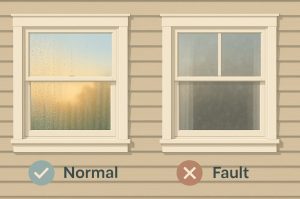
In most instances, homeowners do not need to worry about misty or dewy windows on the exterior. The presence of external condensation is generally seen as a sign of a high-performance window that retains heat inside the property.
It may be helpful, however, to monitor the frequency and pattern of condensation. If one particular window always shows condensation while others do not, or if it persists into the afternoon, it may point to localised environmental factors. Persistent condensation in sheltered areas may be caused by blocked airflow or vegetation holding moisture near the window.
Misty windows should only be a concern if:
- Moisture is found between the panes, indicating a failed seal
- It occurs in conjunction with cold draughts or rising heating bills
- Water begins to pool at the base of the frame
In these cases, it is advisable to contact a glazing specialist for a full assessment.
How Does Condensation Indicate Window Thermal Performance?
Condensation on the outer pane of a window is often a reliable indicator of strong thermal insulation. When the inner environment is well-insulated, less heat escapes through the glazing. This means the external pane remains cool, especially overnight, increasing the potential for condensation.
Windows that rarely show condensation on the outside may be less efficient, as more internal heat is passing through to warm the outer surface. This allows moisture to evaporate or prevents it from forming at all.
Several factors contribute to this thermal behaviour:
- Low U-value ratings indicate better insulation
- High-performance Low-E glass reduces heat loss
- Argon-filled double or triple glazing enhances energy retention
- Warm-edge spacer technology maintains temperature balance across the pane
In this way, visible condensation on the outside of the window can be seen as indirect evidence of a home that is well-sealed and energy efficient.
Conclusion
Condensation on the outside of windows is a natural occurrence, particularly with modern energy-efficient glazing. Far from being a problem, it often indicates excellent insulation and minimal heat loss from the home. While it can be visually disruptive at times, it poses no threat to your property and generally resolves itself quickly.
Understanding the causes and implications of external condensation can offer peace of mind and ensure that homeowners continue to enjoy the benefits of energy-efficient living. If ever in doubt, a qualified glazing specialist can assess and advise based on your specific window setup.
FAQs
Can external condensation damage window frames or seals?
No, external condensation does not damage the window unit. It forms on the surface and evaporates naturally without affecting frames or seals.
Is it normal to see morning dew on new energy-efficient windows?
Yes, it’s very common. In fact, it often indicates that the windows are performing efficiently and reducing heat loss.
Do certain seasons increase the chance of exterior condensation?
Yes. Spring and autumn, with their cooler nights and humid air, are peak times for outside condensation.
Can adding window vents help with exterior moisture?
Window vents affect interior air flow and may not influence external condensation directly, which is caused by outside environmental conditions.
Does external condensation mean my windows are working properly?
Yes. It usually signifies excellent insulation and energy retention, especially in double or triple glazed windows.
How do I distinguish between seal failure and external condensation?
If moisture is trapped between the panes of glass and doesn’t wipe off from the outside, it could be a failed seal. Surface condensation, however, is harmless and temporary.
Should I clean the condensation off or leave it to evaporate?
It’s usually best to leave it to evaporate naturally. However, if visibility is important, gently wiping it with a dry cloth is fine.


